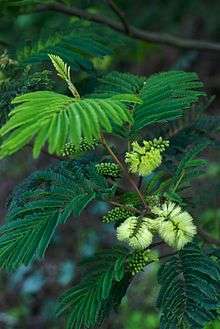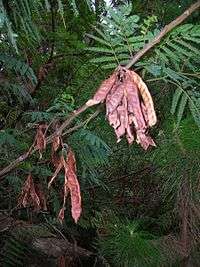Paraserianthes lophantha
Paraserianthes lophantha, commonly called Albizia, Cape Leeuwin Wattle, Cape Wattle, Crested Wattle or plume albizia, is a fast-growing wattle with creamy-yellow, bottlebrush like flowers. It is a small tree (uppermost height approximately 5 metres) that occurs naturally along the southwest coast of Western Australia, from Fremantle to King George Sound.[2] It was first spread beyond southwest Australia by Baron Ferdinand von Mueller, who gave packets of P. lophantha seeds to early explorers under the assumption that if they planted the seeds at their campsites, the trees would indicate the routes they travelled.[3]
| Paraserianthes lophantha | |
|---|---|
 | |
| Scientific classification | |
| Kingdom: | |
| (unranked): | |
| (unranked): | |
| (unranked): | |
| Order: | |
| Family: | |
| Subfamily: | |
| (unranked): | |
| Genus: | |
| Species: | P. lophantha |
| Binomial name | |
| Paraserianthes lophantha (Willd.) I. C. Nielson | |
| Synonyms | |
|
Albizia lophantha | |
It is considered a weed in the parts of Australia where it is not indigenous,[4] as well as in New Zealand, South Africa, the Canary Islands, and Chile.

See also
- Invasive species in Australia
- Invasive plants of Australian origin
References
- The Legume Phylogeny Working Group (LPWG). (2017). "A new subfamily classification of the Leguminosae based on a taxonomically comprehensive phylogeny". Taxon. 66 (1): 44–77. doi:10.12705/661.3.
- "Paraserianthes lophantha (synonym Albizia lophantha)". 2003-12-16. Retrieved 2008-09-28.
- http://www.weeds.org.au/cgi-bin/weedident.cgi?tpl=plant.tpl&ibra=all&card=E10# Archived 2008-08-04 at the Wayback Machine
- "Weed of the month archive". Angair Inc. Retrieved 2013-08-27.
Further reading
- Randall, Roderick Peter (2002). A Global Compendium of Weeds. Melbourne: R. G. & F. J. Richardson. ISBN 978-0-9587439-8-3.
- Blood, Kate (2001). Environmental Weeds: A Field Guide for SE Australia. Mount Waverley, Victoria: C. H. Jerram & Associates. ISBN 978-0-9579086-0-4.